To understand why you should lead by example, we need to look at the history of management.
The management theories have been designed to drive people towards a common goal. In the previous century the dominant style of leadership was a command and control management.
However, this method has two inherent flaws. First, it means that you are not using the creativity and knowledge of your colleagues. And academic research has proven that the collective intelligence is generally more effective.
Secondly, it would be a denial of our human nature. We are not performing well under stress. Our performance is generally optimal in the “flow” zone, as described by Csíkszentmihályi, between boredom and extreme tension or stress. In other words, we are excelling when we feel motivated, engaged and inspired by our leader.
As a consequence, good leaders need to craft a stimulating vision. They need to influence.
“PEOPLE DO WHAT PEOPLE SEE” John C. Maxwell
Yet what would be the result if your boss doesn’t “walk the talk”? The message would not be aligned with acts and it would loose all its influence. That’s the reason why we need to lead by example.
But what does it mean? How can you lead by example? When you understand that the goal is to extract “collective intelligence”, everything becomes clear.
Table of Contents [hide]
1. Be optimistic and courageous
That’s the starting point to have a positive impact on your team: emotions are contagious! So, when you have no reason to be a control freak, choose a positive attitude.
Concerning the courageous attitude, it will authorize ambitious but achievable performance. Furthermore, going out of your comfort zone is the best way to learn and progress.
2. Be empathetic and listen
If you connect with the emotions of your colleagues, you will gain trust. And trust is a basic ingredient of team performance. Support a coworker when he has a bad day. When he has done a mistake, show your understanding and humanity. We are not machines. Creativity needs experimentation. Unless it becomes your signature, failure is an opportunity to learn.
3. Engage people in the decision process
A good decision is not systematically a decision taken quickly and authoritatively. Best decisions are taken with the optimal amount of information and this optimal amount differs depending on the situation.
Engaging your team in the information gathering is an easy solution to create buy-in. The leader is responsible to determine when the optimal amount of information has been reached or when the marginal cost is expected to be bigger than the marginal revenue extracted from an additional information. Then starts the converging process where the different options are explored and eliminated.
If no consensus is reached, the leader can take responsibility of the final decision. Thus, buy-in and knowledge are maximized during all the decision process.
4. Be trustful and transparent
Encourage people to take initiatives. Delegate. Make the growth of your employees your main goal. Because engagement is positively correlated with learning. Don’t let your employees get bored!
Be transparent. Hiding information will create unnecessary insecurity and stress. And, of course, don’t lie! We all hate liars and we generally don’t forgive or forget a lie.









